slobberinbear
Ursine Skald
Introduction to City Placement and Specialization:
a Walk-Through
a Walk-Through
The purpose of this article is to provide beginning and intermediate players with some concrete examples of city placement and suggested city usage.
For the purposes of this article, I will define cities in the following categories:
Capital: Your starting city, typically with strong food and production capability and some commerce capability. It is typically the best suited for building early wonders and cranking out settlers and workers in the early game. Many end up being high-performance hybrid cities in the late game.
Commerce: a city that works an abundance of commerce tiles, typically cottages built on riverside grasslands and floodplains. Jungle areas with calendar resources are also excellent commerce sites.
Production: a city that generates hammers for production, usually with mines. A balance between food and hammers must be met in order for production cities to meet their maximum potential.
Hybrid: a city with a blend of food, commerce, and hammer production.
Great Person Farm / Specialist City: A city that uses a large food surplus from food bonus tiles to run many specialists, either with the Caste System civic or by building specialist-enabling buildings. The specialists in turn generate production and great person points for Great People.
Strategic/Resource City: A city that lacks long-term growth (typically, it is food-poor) but that gathers key new resources or blocks other civilizations from settlement.
I will also try to follow the following guidelines, in no particular order, when settling new cities:
- Settled towards opponent
- Presence of nearby food tiles, especially food bonus resources*
- Presence of nearby strategic resources
- Presence of nearby commerce resources
- Blocks AI civilization
- Riverside
- Fresh water
- Grassland
- Hills for mining
- Few "trash" tiles (ocean, desert, mountain, ice, tundra)
- On a hill / behind a river / defensive bonuses
- Coastal
- Minimal harmful overlap**
* Many players use a "food scoring" system when evaluating city sites. Essentially, take all tiles' improved food values -2. Assume all bonus resources have the appropriate improvement (farm, pasture, etc.) Add these numbers up. If the number is negative, that's the number of farms needed, pre-Biology, to work all the workable tiles in the BFC.
** I define "harmful overlap" as cities that have overlapping workable areas such that both cities cannot be reasonably productive at the same time.
The map used in this example is the familiar Earth18Civs scenario installed with Civ IV. The sample game was played at Emperor level, Epic speed. I have chosen to use America/Roosevelt for these examples as there are a variety of city types available, room to expand, and the spread-out resource allocation is fairly typical of a random map game. Obviously, knowing the general layout and resource location is an advantage for this example, and more scouting is required on a random map than I have done in this example.
Here is the eastern part of North America, in World Builder mode:
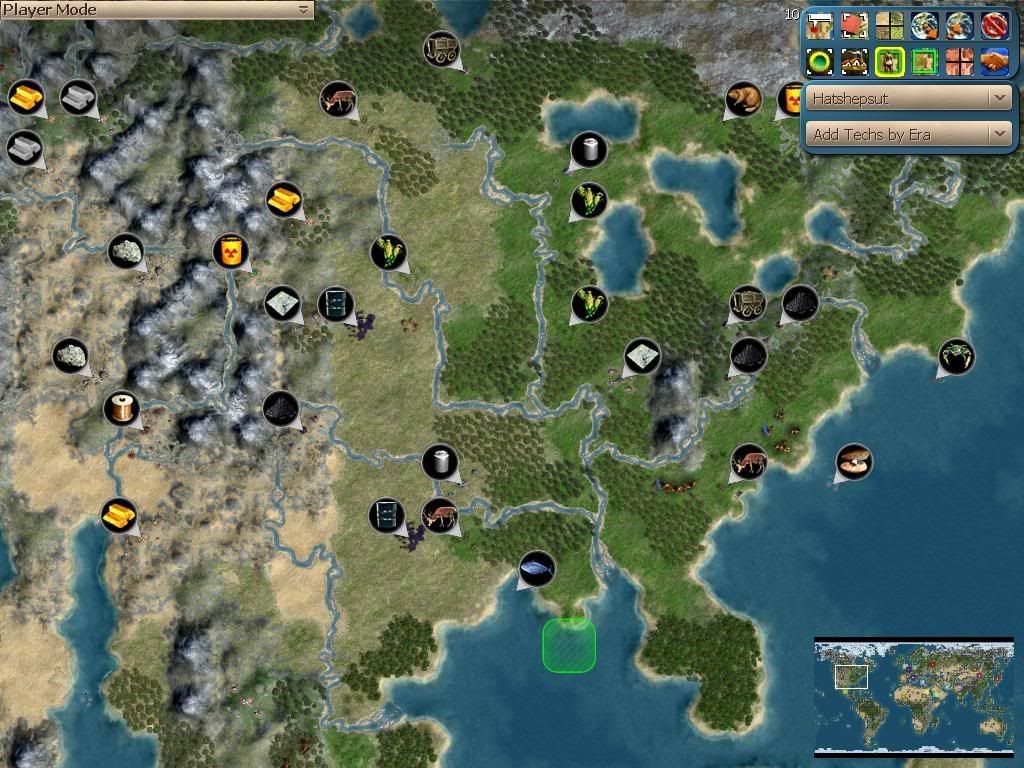
1. Starting Situation: the Capital
The first step is to assess your starting situation and compare it to your leaders traits, starting technologies, and civilization unique units and buildings.
Here is Roosevelts start:
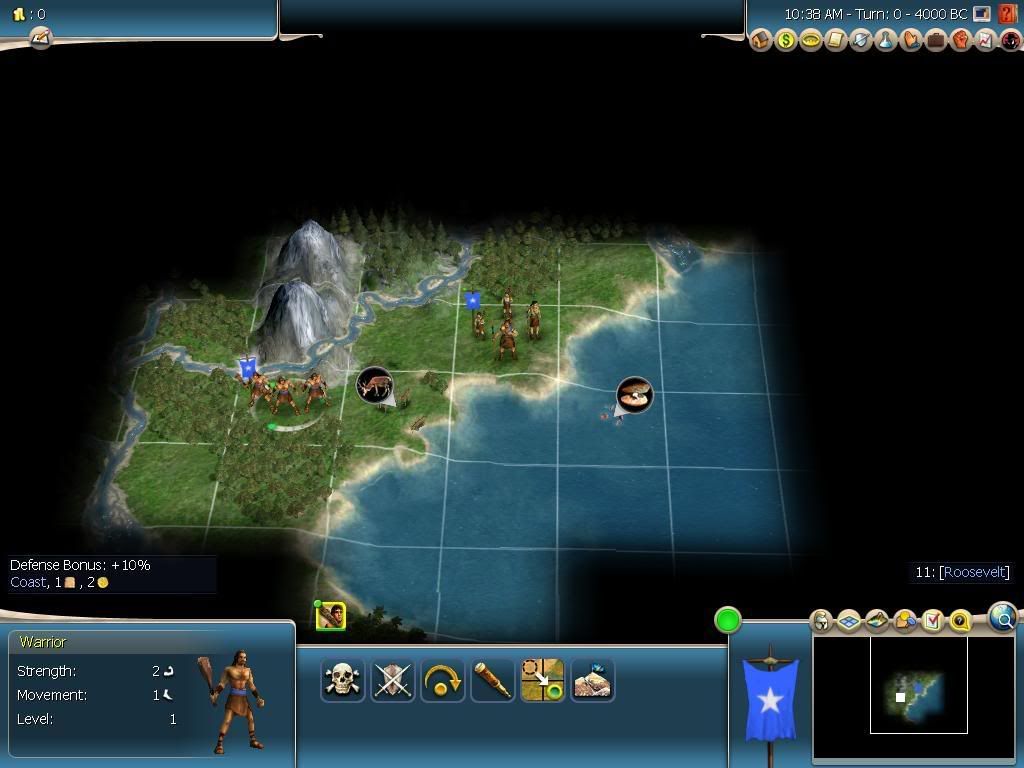
As you can see, this is a perfectly acceptable starting location with two bonus food resources, a river providing bonus commerce and fresh water, and hills that can be mined. Since America begins with both Fishing and Agriculture, the starting location allows us to build workers or workboats right away for immediate food production.
In this example, we must also consider that, as a real world scenario, we know that Montezuma is nearby to the southwest. We want to get cracking right away before the Aztec jaguar warriors show up in force. Let us assume that we settle in place (and there are ample reasons to do so, if you refer to the worldbuilder map above -- iron and coal aplenty!). Note that the location 1W of the settler could also be settled to get fewer coastal tiles, but this causes more overlap with the cities described later in this article.
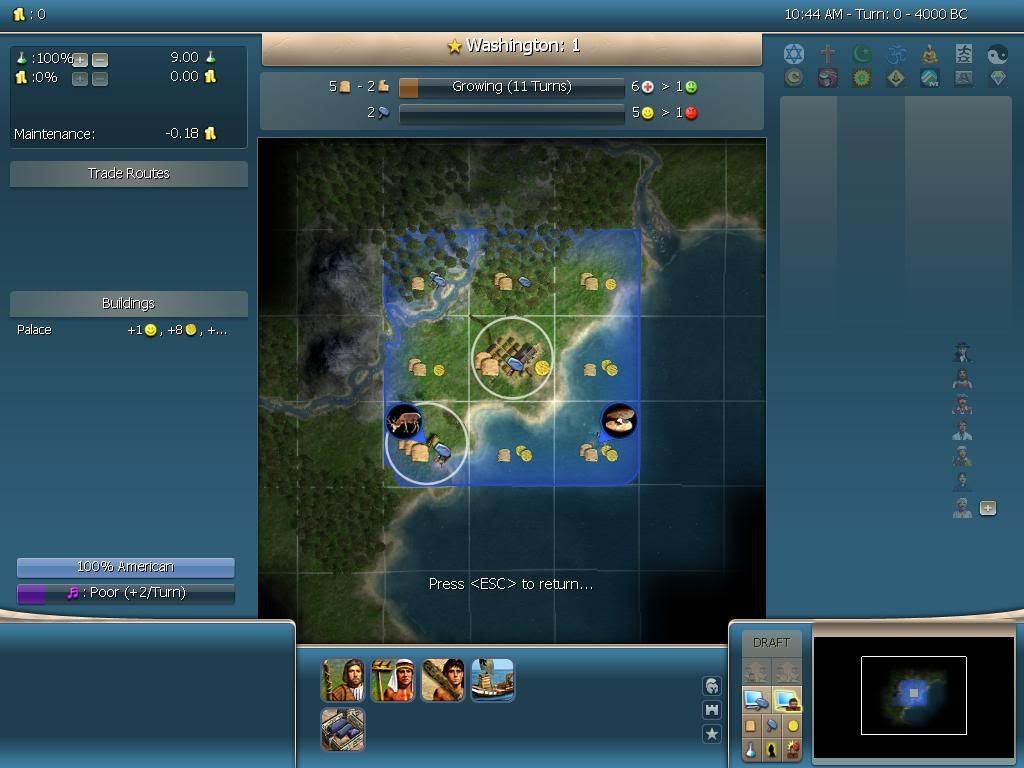
What is the best use for Washington?
Like all capitals, Washington must function as the main production city for the first 3000 years of the game. This means it must have sufficient food and hammer production to crank out workers, settlers, and garrison units. Remember also, however, that Roosevelt is Industrious with a 50% bonus to wonder production. Washington also has sufficient wood to allow fast construction of an early wonder or two.
However, Washington is not perfect. The abundance of coastal tiles, two mountain tiles, and just three hills combine to limit the citys upper-end productivity. That said, Washington is more than adequate for the early and mid-game. Since there is plenty of food from the deer and clams to feed the mine tiles, the riverside grassland tiles can be farmed (providing food for specialists), cottaged for extra commerce, or watermilled in the mid-game for more production. This is a classic hybrid city.
Given the starting situation, many World Wonders are appealing for Roosevelt, and Washington should be able to make two or more of them in the early game. With the abundance of coastal locations, the Great Lighthouse and Colossus should be high on the list. The Oracle, Parthenon, Temple of Artemis, and Great Library are also worth consideration due to the nearby marble resource. The early stone wonders (Stonehenge, Great Wall, and Pyramids) are all useful but will have to be built with wood chopping unless stone (to the far west ) can be hooked up quickly.
City Name: Washington
City Type: Capital / Wonder Factory / Hybrid city
National Wonders: National Epic / Iron Works / Moai Statues
Key Buildings: wonders, lighthouse, granary, barracks, forge.
2. Tech and Build Orders
Once you have settled your capital and formulated some ideas going forward, its time to settle on preliminary technologies and builds. In most instances, you are best served by improving your capital somewhat before settling a second city. In the case of Washington, a worker and workboat should both be built before a settler. Since a workboat can be built while the city grows, well build it first, followed by a worker than a warrior.
To access the deer, we will need Hunting. To mine the hills, well need Mining and Bronze Working. Hunting also leads to Archery, a nice defensive technology. Well go with that initial tech order: Hunting, Mining, Bronze Working.
By turn 38 (epic speed), we have finished our boat, worker, and warrior. Washington has grown to size 3, and there are no visible bonus resource tiles to work that are not already worked. Time to build a setller!
Once Bronze Working finishes, we discover copper to our north, near present-day Ottowa. We also have a decision to make, tech-wise:
There are several options here. As our land is ripe for cottages, it is attractive to consider The Wheel and Pottery. But we are Industrious, and should consider building an early wonder. Researching Sailing and Masonry will enable the Great Lighthouse, Great Wall, and the Pyramids. We will also need to consider Mysticism so that our new cities can build monuments to grow their borders particularly since Monty has founded Hinduism and will have growing cultural borders.
Lets research Mysticism, Masonry, then Sailing. As a bonus, Mysticism is one of Masonrys prerequisites and will make Masonry cheaper.
3. New Cities and specialization
On turn 52, aided by a workers chop, the settler finishes, and a city to the southwest (near New Orleans) is planned. Why?
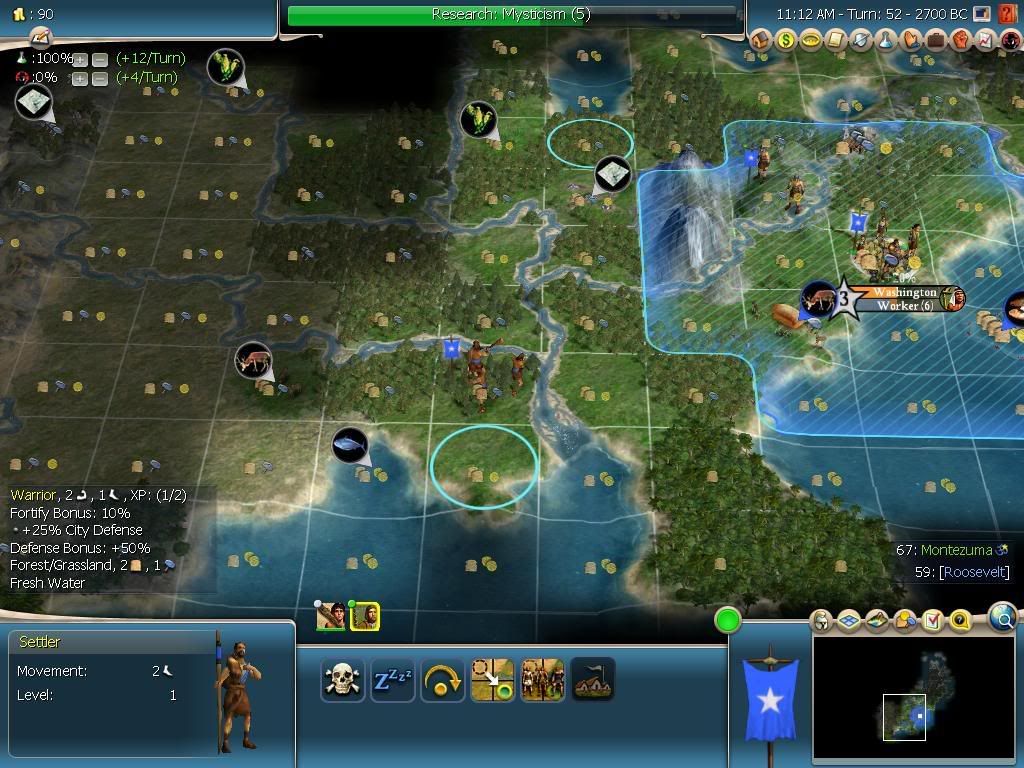
The city has both deer and fish, and is also located on a river with a lot of grassland. This alone would make it a great city for cottages (remember, cottages get +1 commerce each if riverside), but also consider that by taking this spot, we are depriving it from Monty.
We settle New Orleans:
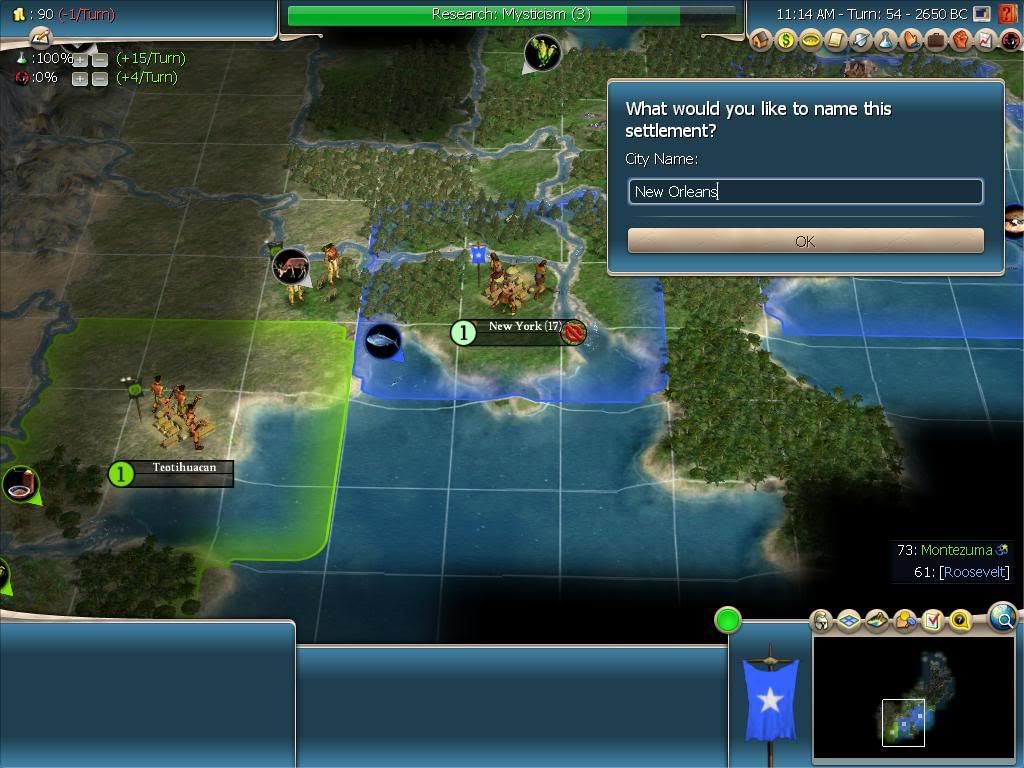
And just in time, too Monty has settled another city to the southwest. New Orleans will need some culture to keep its cultural integrity, and some defenses too to discourage Monty from attacking. In the meantime, it starts on a workboat for its fish tile and will build a monument, lighthouse, and walls when those enabling technologies are researched.
City Name: New Orleans
City Type: Commerce City
National Wonders: Oxford University, Wall Street
Key Buildings: lighthouse, culture buildings, library, marketplace
On turn 58, our second worker finishes in Washington and goes to New Orleans to chop wood to speed construction of the workboat and monument there. Another warrior and settler are lined up for production in Washington.
On turn 71, our second settler and warrior escort are complete, and head northwest, to Chicago:
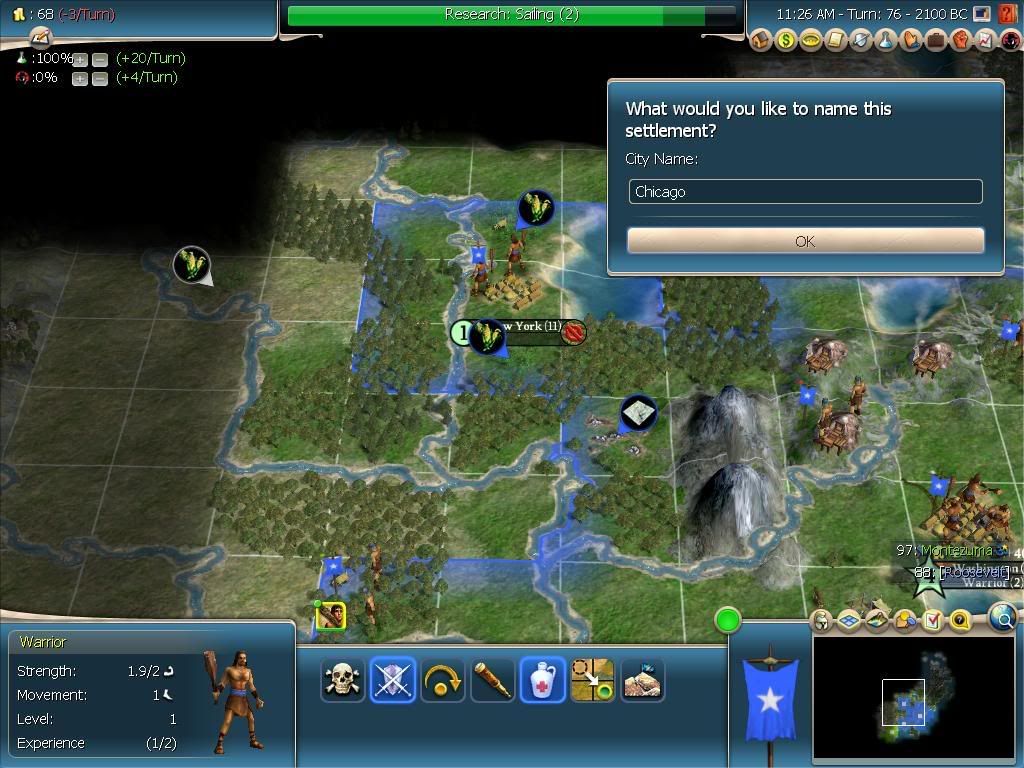
Chicago is another powerhouse city, different from New Orleans in several key ways. With its two irrigation-ready corn tiles, food production will be enormous there. The plentiful riverside grassland also provides lots of flexibility in the direction the city will take. Farm it for more food and specialists; cottage it for more commerce; or watermill it for more production!
In the early game, unless we have access to the Pyramids and the Representation civic (for bonus research from specialists and even more specialists with the Caste System civic), the cottages are too attractive to pass up. But well need to research Monarchy so that we can run the Hereditary Rule civic and grow Chicago nice and big! We cant really use all that food unless the city is allowed to grow!
City Name: Chicago
City Type: Great Person Farm or Commerce City; settlers and workers early
National Wonders: Oxford University, Wall Street, Globe Theater
Key Buildings: library, marketplace
On turn 76, our third worker finishes in Washington and follows the settler to Chicago.
Once Sailing finishes, its time to consider tech choices again. Given our need for cottages and defense, well go with The Wheel, Pottery, then Archery.
On turn 82, we finish a Lighthouse in Washington, enabling our first wonder the Great Lighthouse!
Meanwhile, our diligent wood chopping allows hammer-poor New Orleans to complete its Lighthouse and Walls quickly.
On turn 98
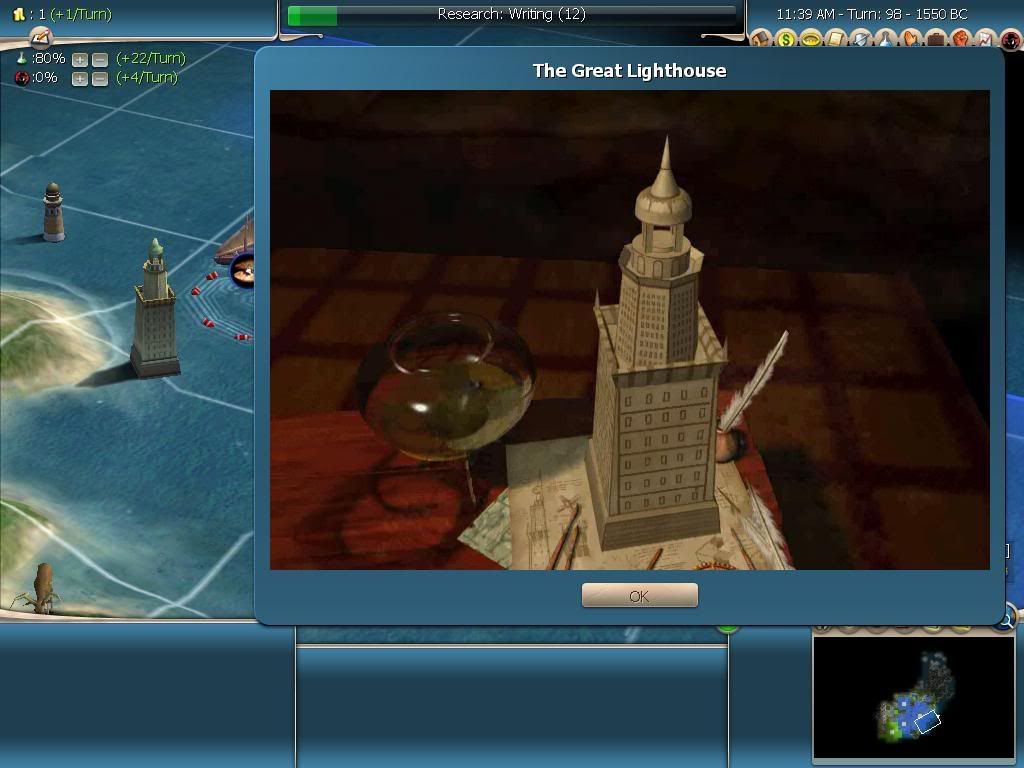
Wonder #1 complete! Washington turns to building a settler, as does Chicago, which has been growing rapidly due to the farmed corn tiles.
Weve also finished Archery. Time to improve research and get happiness increased, so Ill research Meditation, Priesthood, Writing, and Monarchy. Note that I could research Writing first, but I am delaying it until after Priesthood for an additional discount (since Writing has three possible prerequisites).
One of the nice things about having a worker for each early city the initial city size is small due to lack of happiness, freeing up your worker to help with new cities and build roads. Remember, you dont have to improve every tile right away. If your happy cap is 7, it makes no sense to improve 12 tiles.
Time for city #4:
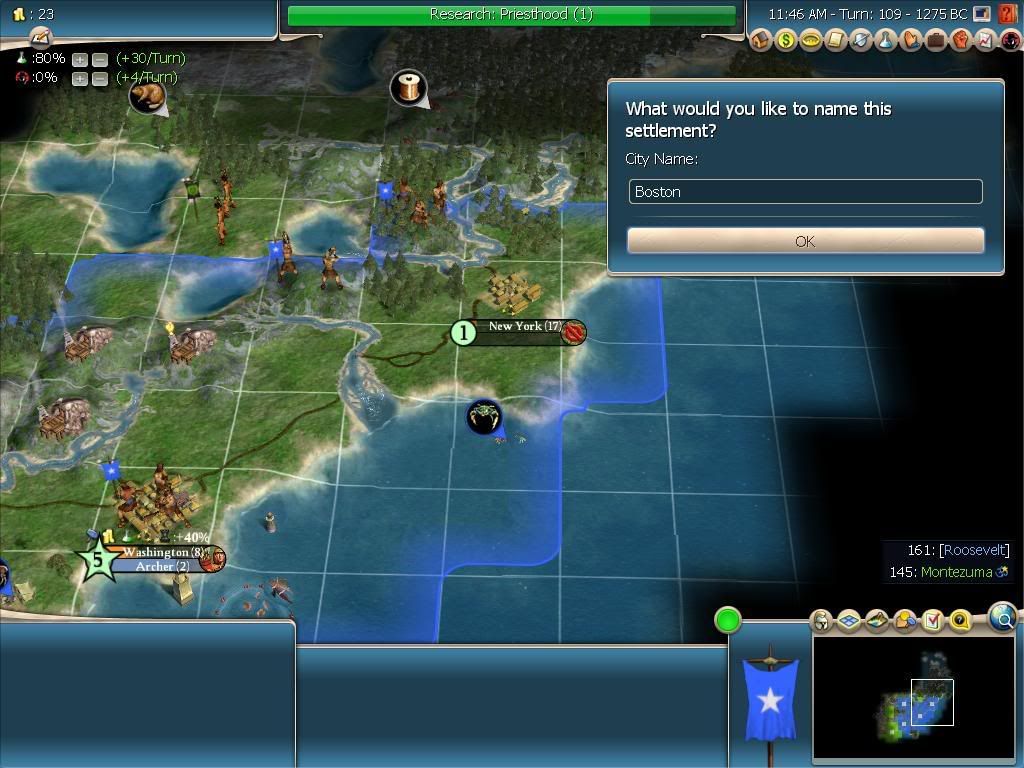
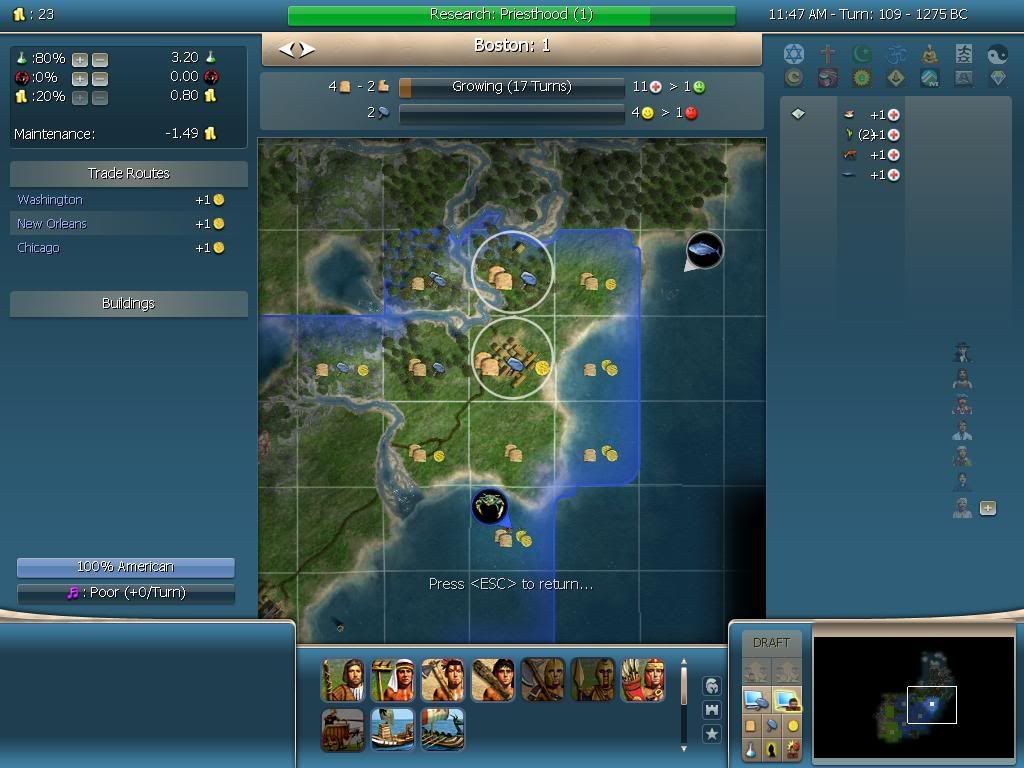
Boston is a nice coastal production city, with two bonus food resources and four hills for mines. It will make a nice armory and shipyard. Again, the riverside grasslands give us the flexibility to make food, commerce, or production.
City Name: Boston
City Type: Production City
National Wonders: Heroic Epic, Moai Statues, West Point
Key Buildings: barracks, lighthouse, forge, granary
For city #5, using Chicagos settler, we have this bit of a poser:
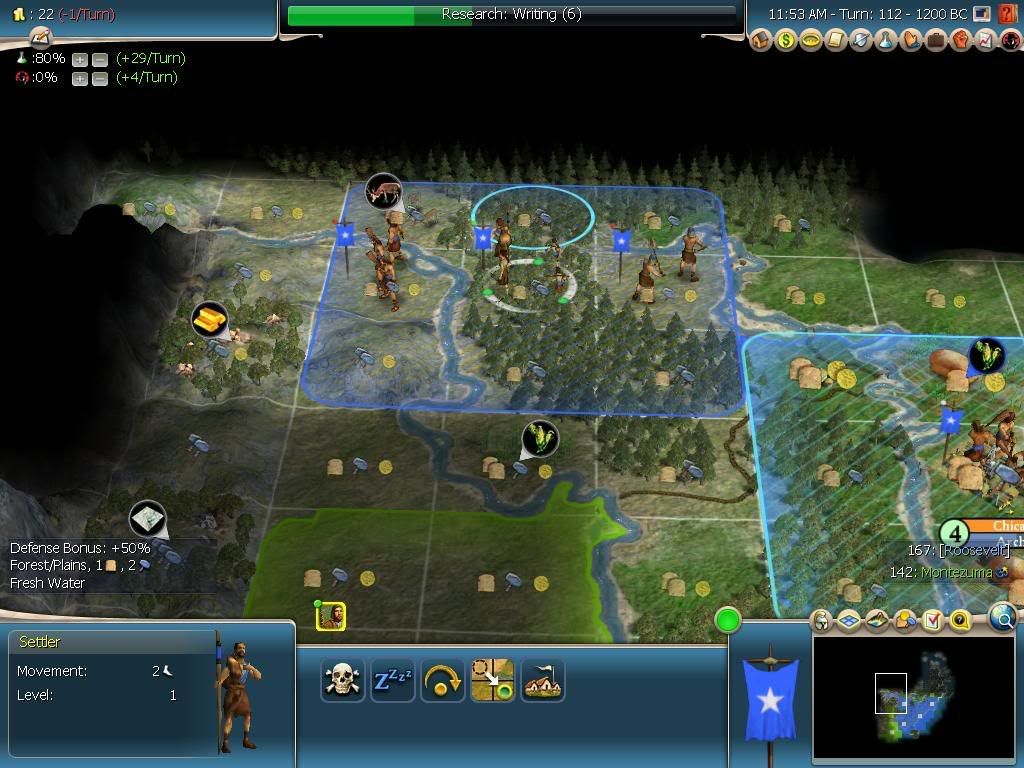
As you can see, Monty has settled in the vicinity of Denver and will grow to take the corn and marble tiles. However, he will miss the gold and deer to the north. A city here will block Monty from continued northward expansion, get the gold and deer, and possibly get the corn tile. While the city is close to Chicago, moving it westward gains it more useless Rocky Mountain tiles and moving it north will lose the gold. The current position does get a few grassland riverside tiles that can be farmed for extra food, which will be needed in this northern plains clime. There is also a hidden iron resource in Buttes borders, which turned out to be a bonus.

City Name: Butte
City Type: Resource / Strategic City / Secondary Production city
National Wonders: none
Key Buildings: barracks, forge, granary, library
Lacking a good amount of food (absent the corn), Butte will always be a second-class city, but its placement at this stage of the game preserves all of Canada for American settlement. If we can get the corn tile from Monty, Butte will be significantly better, but of course only one city (Butte or Monty's city) will be able to work it at a time.
Meanwhile, Hinduism (Montys religion) has spread to both New Orleans and Washington. More happiness at this stage of the game is good, and perhaps sharing a religion will keep him off my back a little longer. I adopt it.
Turn 139 brings Monarchy, and I immediately adopt Hereditary Rule:
The next techpath: military. I research Iron Working, Mathematics, and Construction. We need to be able to deal with Monty when war comes!
City #6: Ottowa (or thereabouts):

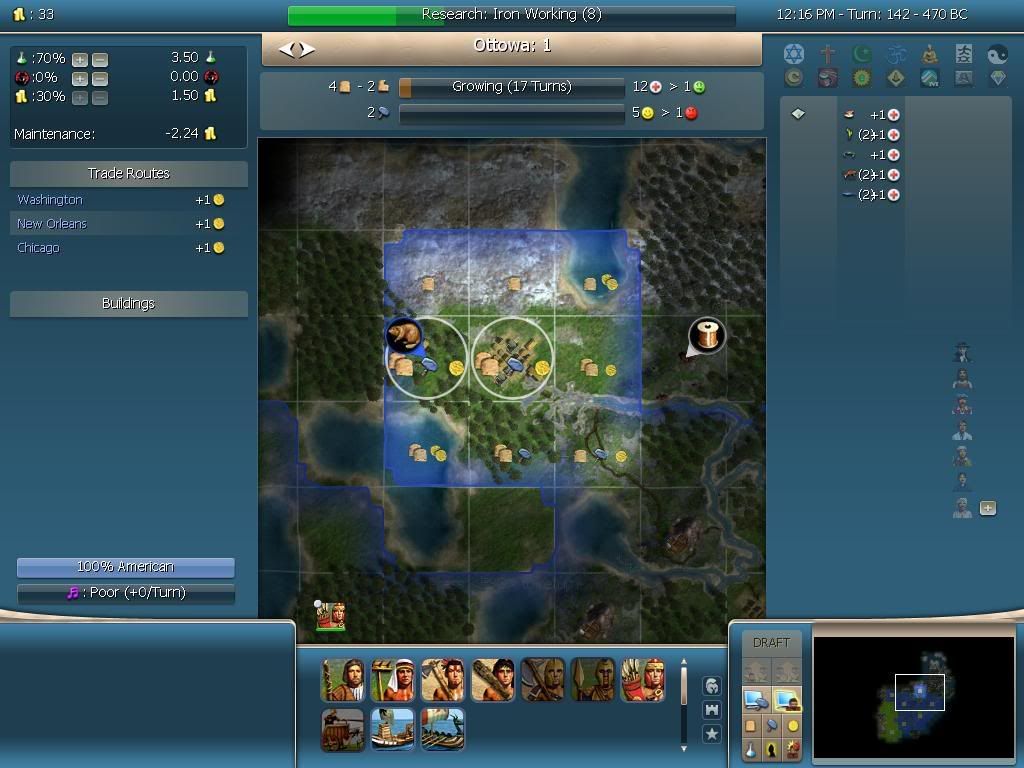
While the tundra tiles certainly dont help, Ottowa gets both copper and furs, is coastal, and has fresh water and three lake tiles. With a lighthouse, lake tiles are worth 3 Food and 2 commerce, functioning better than farms. Ottowa will be useful for building military units in the early game, but its lack of plentiful hills will make it a secondary production city by mid-game.
City Name: Ottowa
City Type: Hybrid/Resource/Production City
National Wonders: none
Key Buildings: barracks, forge, granary, lighthouse
By turn 168, weve beefed up our military, finished Construction, and have built libraries in our commerce cities of Chicago and New Orleans. Our production cities have barracks and are building military units. We have six well-placed cities and a useful world wonder. We have acquired two happiness resources (gold and furs), two strategic resources (iron and copper), and five health resources (deer, corn, fish, clams, and crabs).
Each of our cities is productive and contributing in its own way:
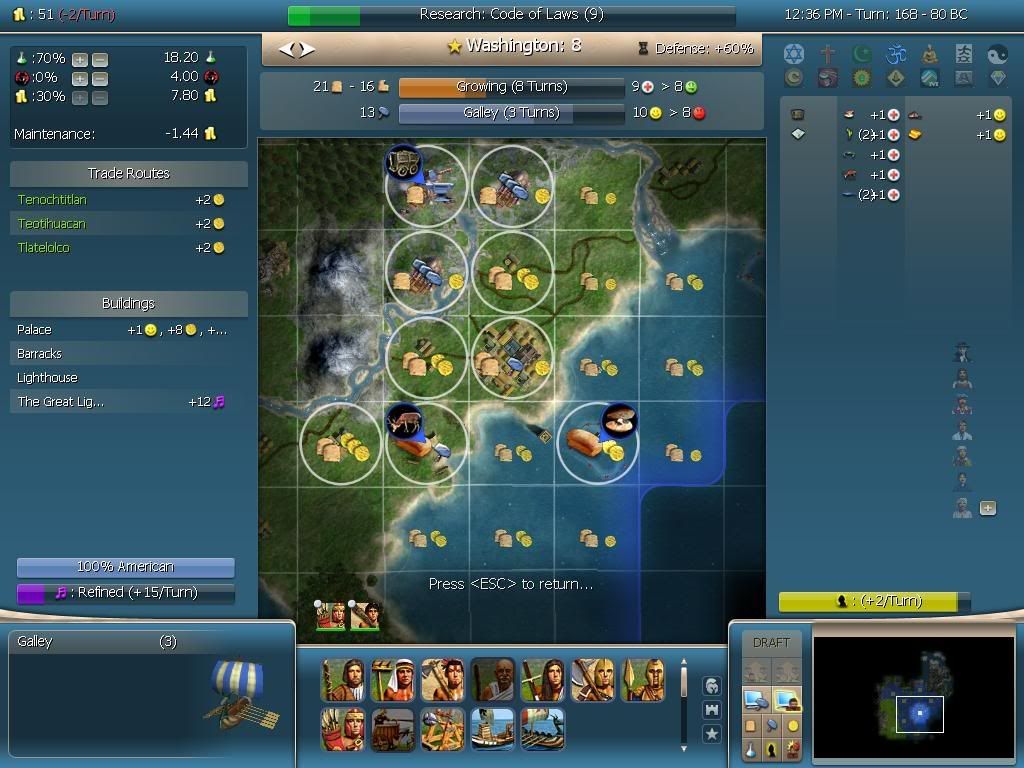
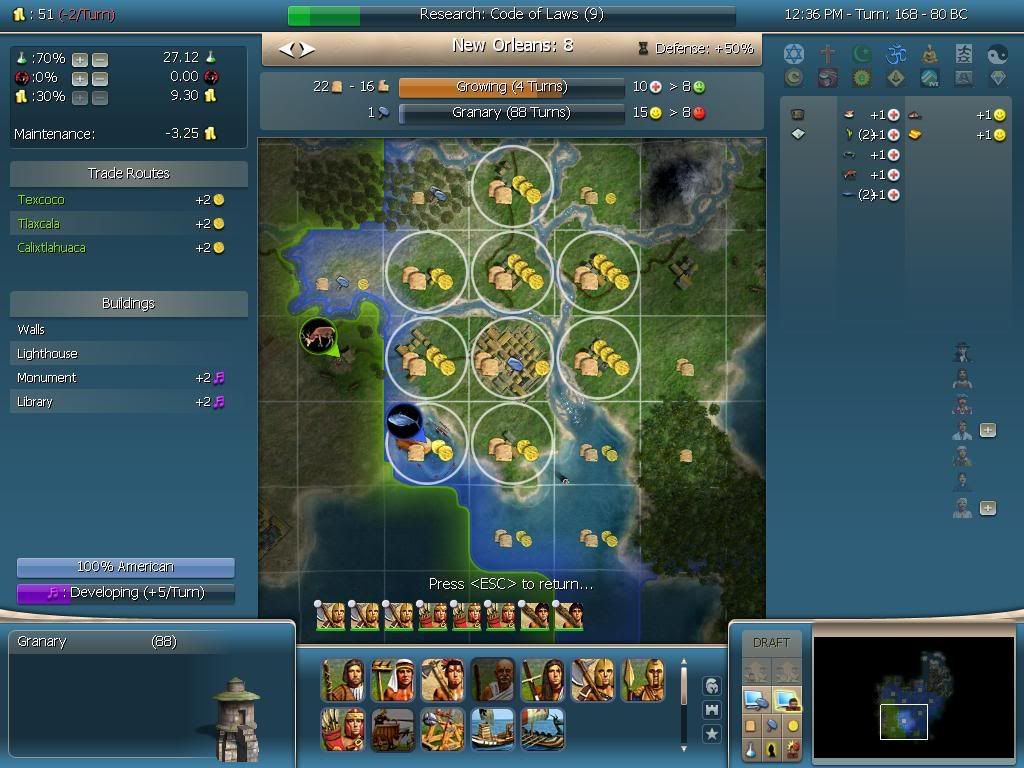
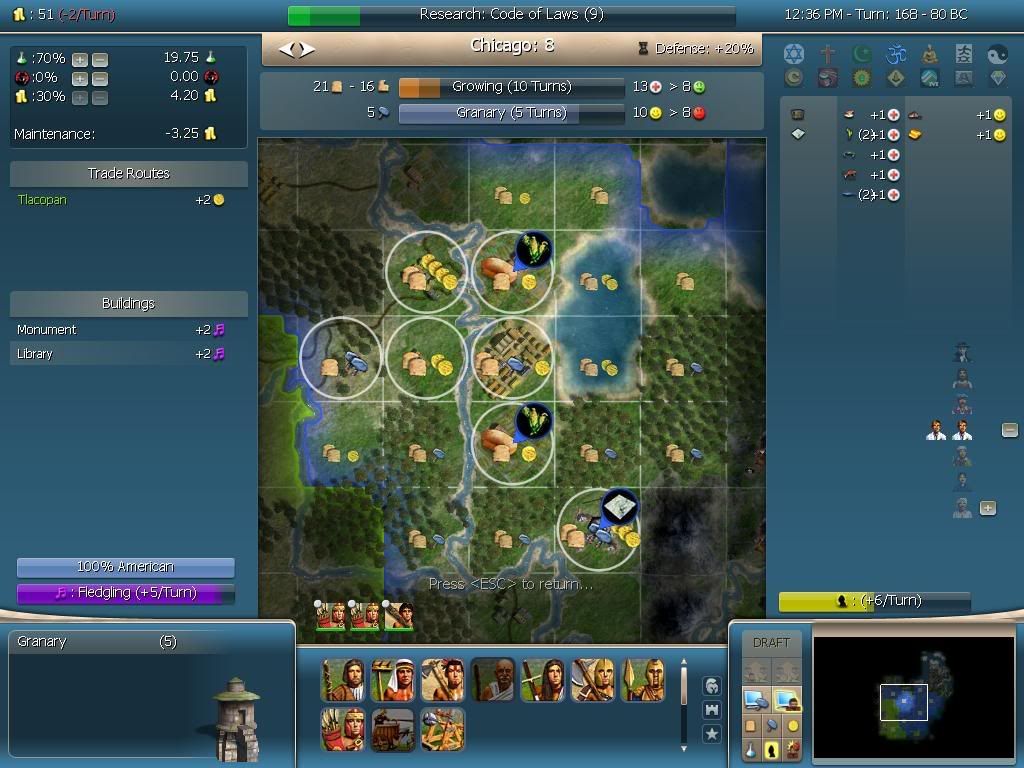
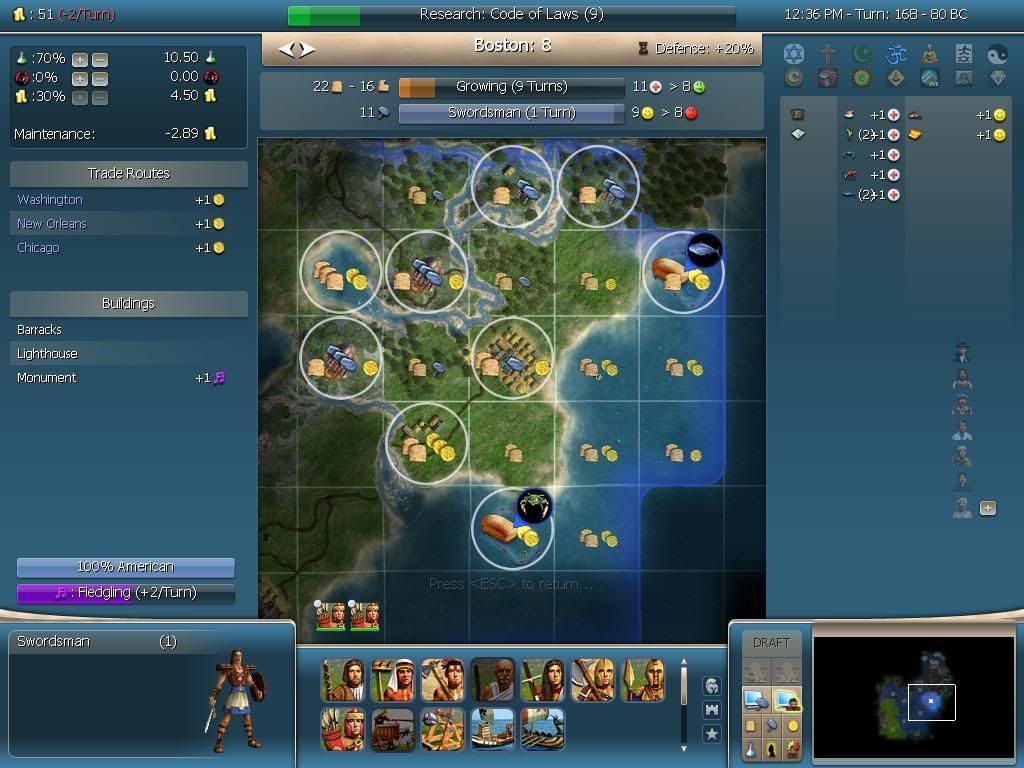
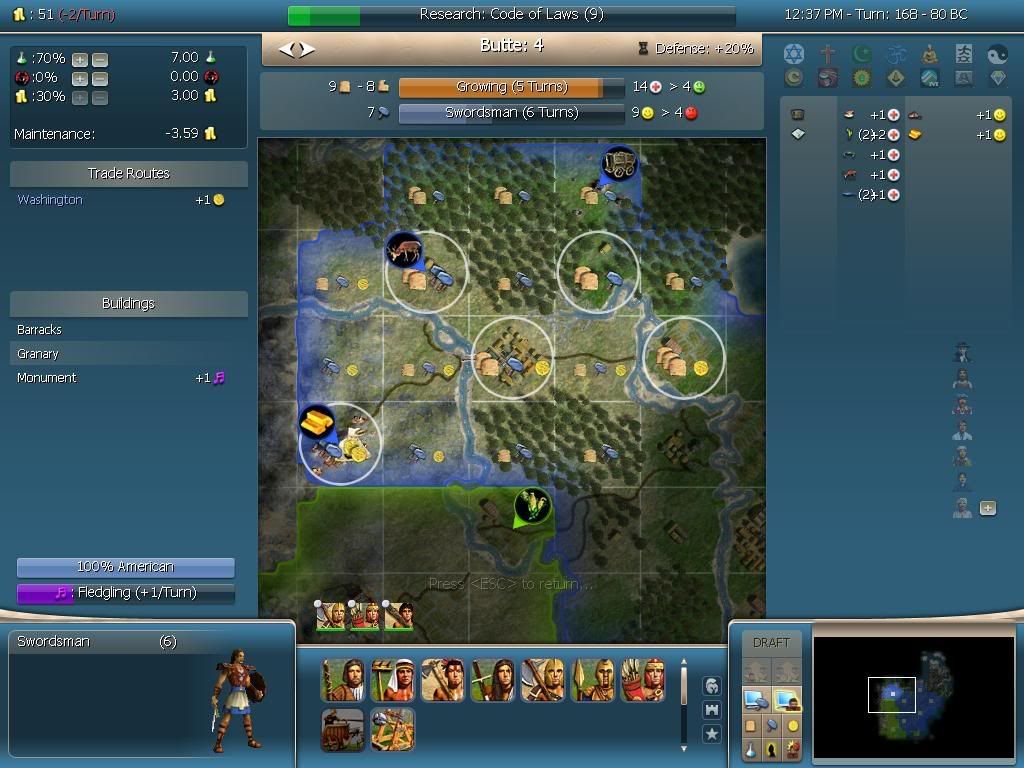
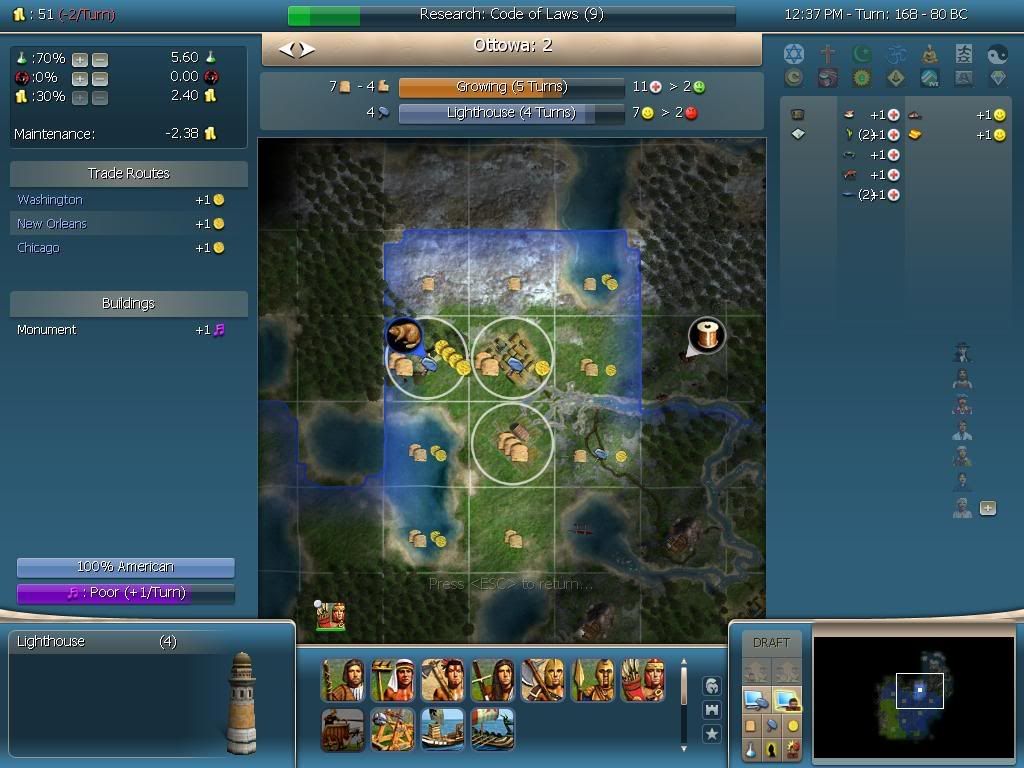
As you can see, not every city has every building, and most cities are working tiles that are improved. I probably should have built another worker or two earlier for this purpose, but we were building units to keep Monty at bay.
Take-away points:
1. Place your cities towards your opponents to grab resources, block opponents, and with an eye towards specialization. While some cities can be placed purely for short-term gain, most should be placed so they will be significant factors in the mid- and late game.
2. Cities generally fall into one of several categories: Capital, commerce (cottages), great person farm (lots of food), production (mines), hybrid (a combination), and resource/strategic (not productive, but necessary for blocking or to grab a resource). You will generally need all types to be successful, especially at higher difficulty levels.
3. Only build wonders and buildings in cities that you need. In the early game, workers, settlers, and military units are critical.
4. Your settlement strategy is not in a vacuum; you must consider foreign relations and technology issues when deciding where and when to settle a city.



